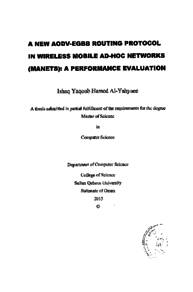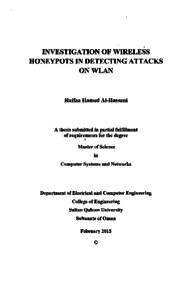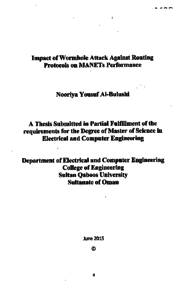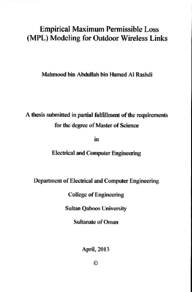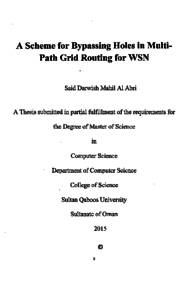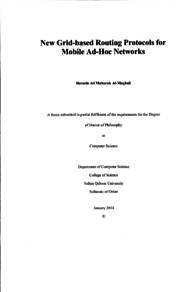وثيقة
A new AODV-EGBB routing protocol in wireless mobile AD-HOC networks (manets) : a performance evaluation
الناشر
Sultan Qaboos University
ميلادي
2015
اللغة
الأنجليزية
الموضوع
الملخص الإنجليزي
A Mobile Ad Hoc Network (MANET) is a collection of wireless nodes communicating with each other in the absence of any fixed infrastructure. The study of MANETs is a developing area of research and efforts have been taken for achieving efficient routing algorithms in mobile ad hoc networks.
In a MANET, to discover a route to a specific destination node, routing protocols use a broadcast scheme referred to as simple flooding, where each node retransmits every unique received packet exactly once. They blindly disseminate route request packets (RREQ) from the source to the rest of the network nodes, which cause high contention, and collision in the network leading to the broadcast storm problem. This thesis focuses on developing a simulation model called Ad hoc On-demand Distance Vector-Extended Grid Based Broadcasting (AODV-EGBB) routing algorithm. It is an enhanced version of the Ad hoc On-demand Distance vector (AODV) routing algorithm.
It uses a new routing request broadcasting algorithm for sending the route-request queries new RREQ. Its aim is to improve the performance of the AODV algorithm by plugging a new broadcasting algorithm called Extended Grid Based Broadcasting (EGBB) [2] for sending efficiently the RREQS.A simulation model based on Network Simulator (ns-2) has been developed for the new protocol. In order to check the improvement of the original AODV, a comparison between the original AODV and the new improved AODV algorithms is measured. The performance results of both algorithms are measured under the following network parameters: network density, node mobility and traffic load. Simulation results show that AODV-EGBB has improved considerably the original AODV algorithm in terms of the end-to-end delay, average reachability, number of dropped packets and number of sent packets. For example, with a traffic of 12 packets/second and node mobility speed of 6 m/sec, the average reachability achieves about 93% in the AODV-EGBB whereas it is 31% using the original AODV when the number of nodes is 300 nodes. In addition, when 150 nodes are placed over an area of 1000 meter x 1000 meter, an average delay of about 0.07 Seco second is reached by the AODV-EGBB when the speed is 12 m/sec, whereas it is 0.15
second for the original AODV which is 53% better.
الوصف
Thesis
المجموعة
URL المصدر
الملخص العربي
نظرا للتقدم السريع في تكنلوجيا الاتصالات اللاسلكية العشوائية (MANET) وتطبيقاتها الواسعة في مختلف مناحي الحياة، تم العمل على الكثير من البحوث في هذا المجال على مدى العقد الماضي وقد كرست الكثير من الجهود في هذه البحوث التطوير كفاءة بروتوكولات التوجيه. في هذه الأطروحة، قمت بتطوير البروتوكول (AODV وهو أحد البروتوكولات التي تعتمد على إنشاء المسار من المصدر إلى الجهة المطلوبة وقت ما كانت هناك حاجة لإرسال بيانات لهذه الجهة ، وينقسم بروتوكول (AODV) إلى مرحلتين أساسيتين هما إنشاء المسار وإرسال البيانات ، ويتمثل التطوير الذي قمت به في حل مشكلة البث العشوائي للحزم الخاصة بالبحث عن الجهة المطلوبة في جميع الاتجاهات وإعادة إرسالها من قبل جميع الأجهزة المستقبلة لهذه الحزم والتي بدورها تؤدي إلى مشكلة عاصفة البث (Broadcast Storm Problem) والتي تؤثر سلبا على أداء البروتوكول وفعاليته ولمعالجة هذه المشكلة، اقترحت تعزيز البروتوكول (AODV من خلال الاستفادة من بروتوكول البث {EGBB) والذي يتمثل في تقسيم الشبكة التي تتوزع فيها الأجهزة إلى شبكة مكونة من خلايا على شكل مربعات افتراضية ثنائية الأبعاد وانتخاب ممثل من كل خلية باستخدام آلية محددة وبعدها تنتقل حزم البيانات بحثا عن المصدر من خلال إعادة بثها من خلية إلى خلية مجاورة لها حتى تصل إلى وجهتها وتتم صيانة بيانات ممثل كل خلية من خلال الاعتماد على البيانات المتبادلة في الشبكة دون الحاجة إلى رسائل خاصة لهذا الغرض. من خلال البحث، قمت بتصميم وتنفيذ نماذج محاكاة وإجراء العديد من تجارب المحاكاة بشكل مكثف باستخدام أداة المحاكاة الشبكية 2-NS تمت دراسة معايير مختلفة لمعرفة كفاءة البروتوكول تحت عوامل مختلفة وهي: حركة الأجهزة وكثافة عدد الأجهزة وتأثير كمية البيانات المتبادلة في الشبكة. وقد أوضحت نتائج الدراسة كفاءة البروتوكول المقترح ( AODV - EGBB مقارنة بالبروتوكول الأصلي (AODV وكان هناك تحسينات كبيرة في الأداء.
قالب العنصر
الرسائل والأطروحات الجامعية

